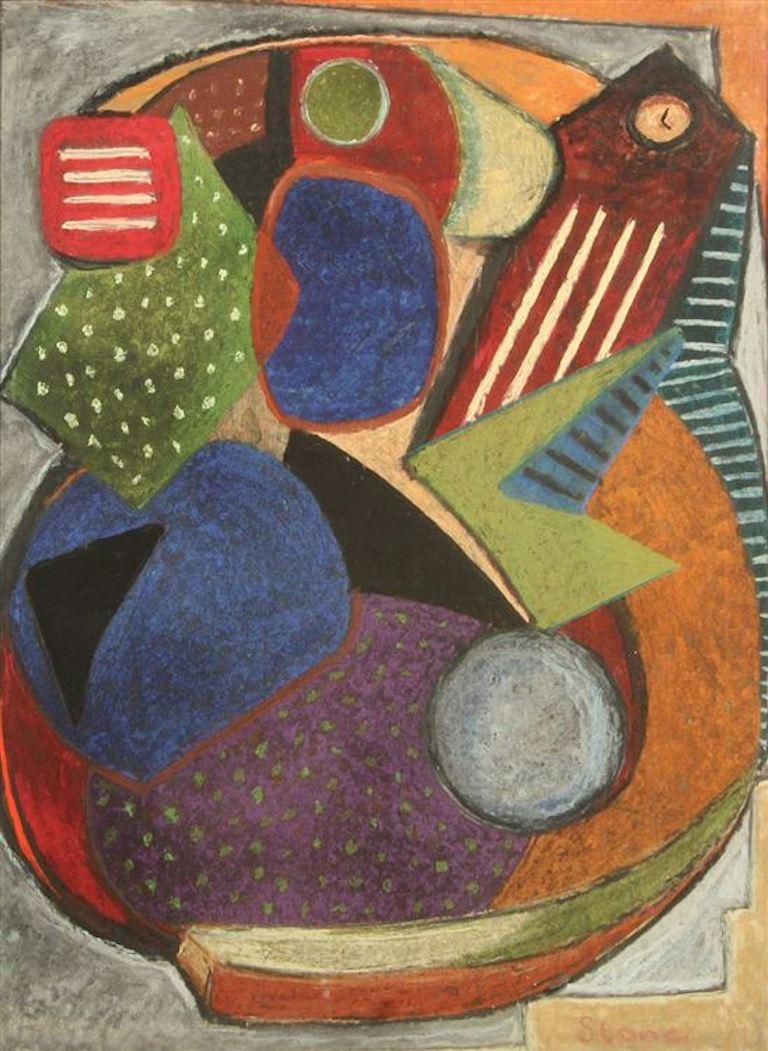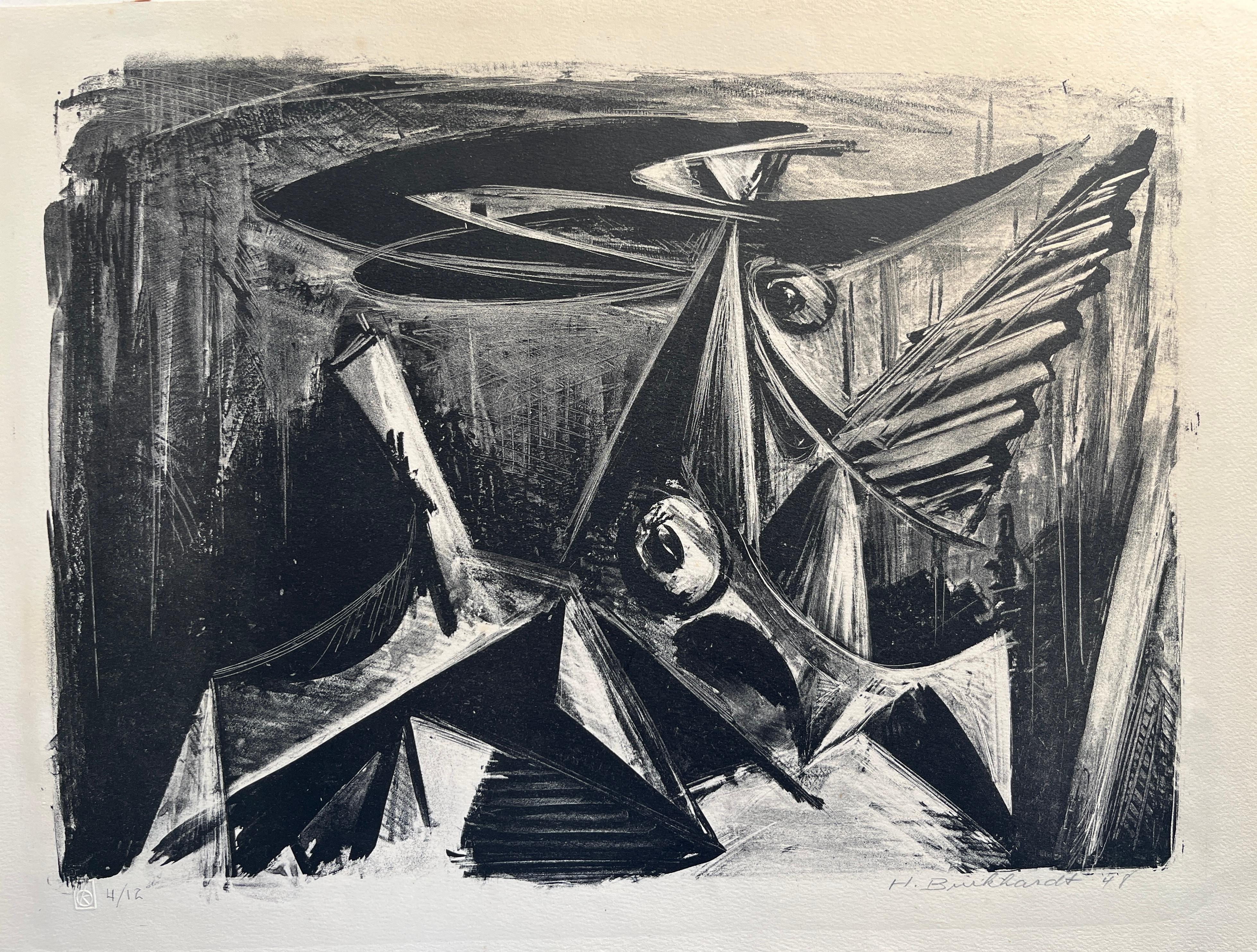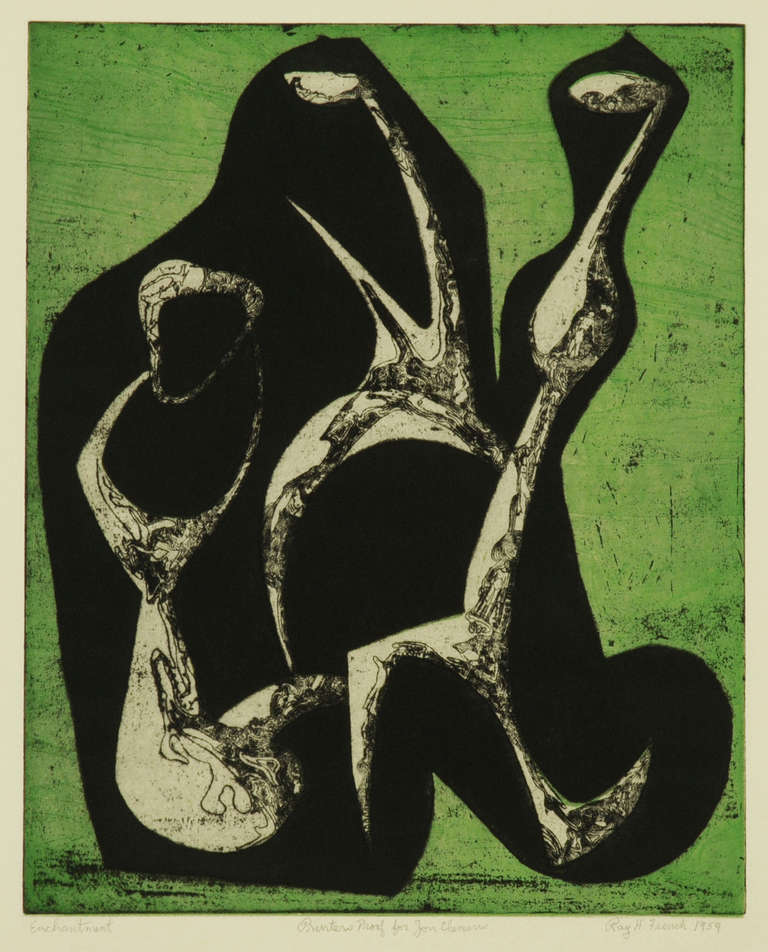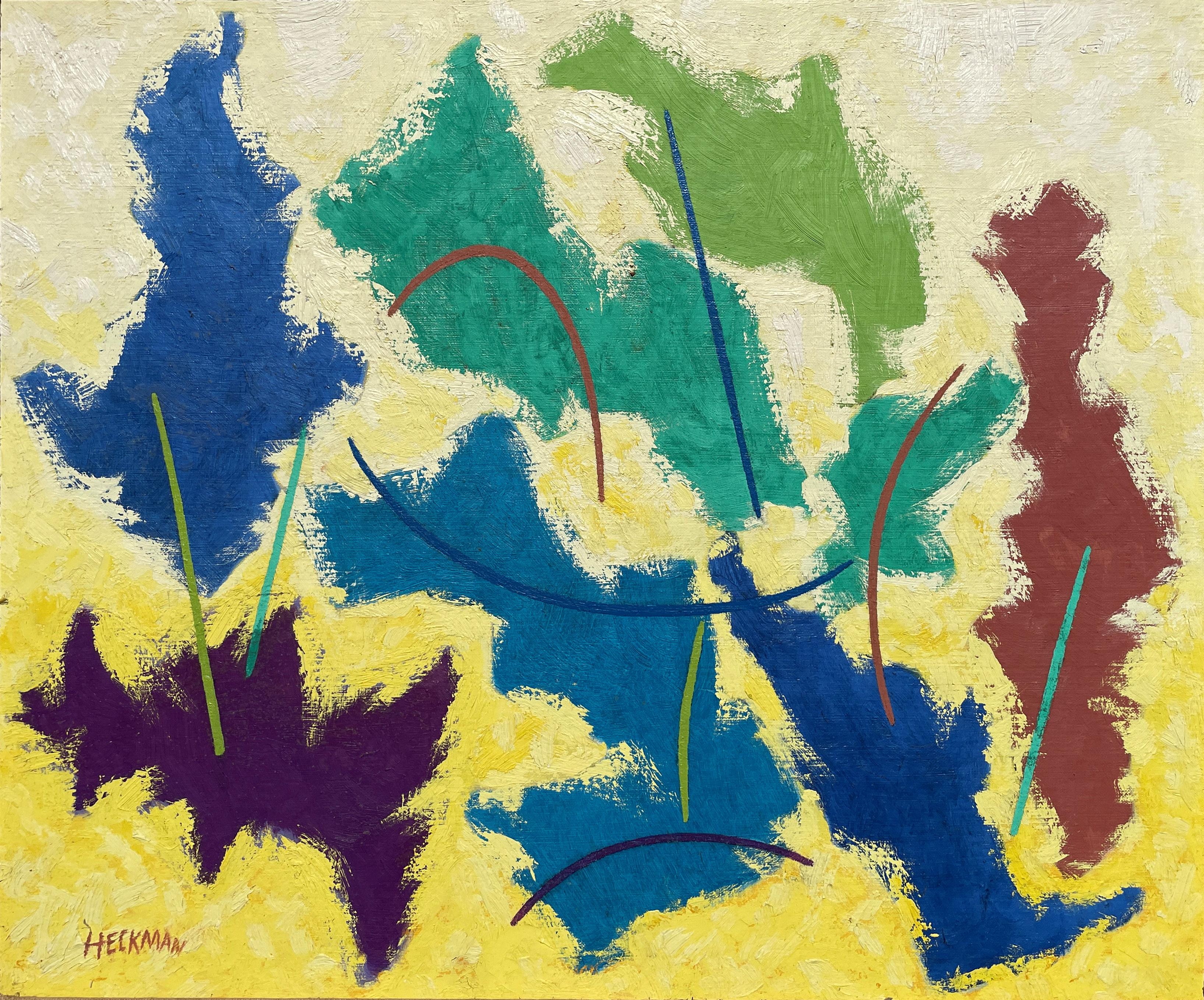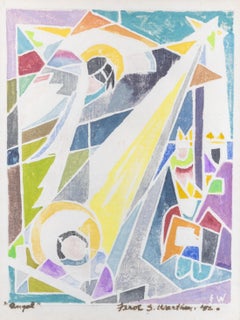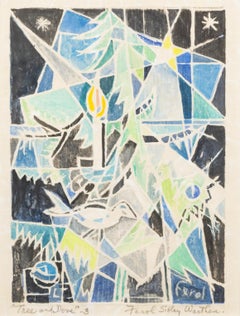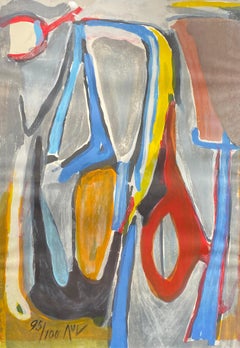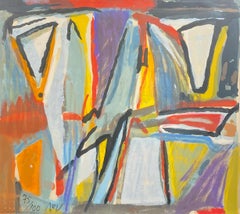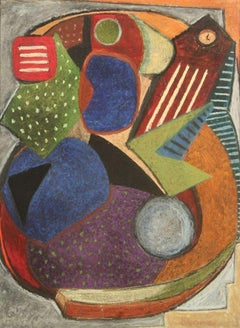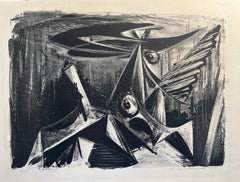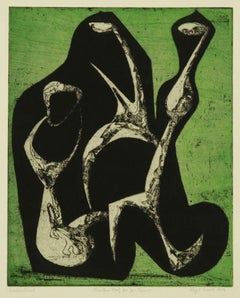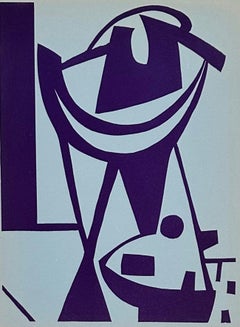Items Similar to Ornaments
Video Loading
Want more images or videos?
Request additional images or videos from the seller
1 of 9
Ferol K. Sibley WarthenOrnaments1953
1953
$3,000
£2,320.38
€2,641.62
CA$4,307.52
A$4,706.09
CHF 2,466.48
MX$56,192.25
NOK 31,213.54
SEK 29,105.97
DKK 19,728.65
About the Item
Ornaments, 1953
Ferol K. Sibley Warthen (American, 1890-1986)
Color Woodblock Print
7 x 4.75 inches
16 x 13.75 inches with frame
Signed and Dated Lower Right
Titled Lower Left
Born 1890, Died 1986, Ferrol Warthen was a member of the Provincetown Printers. She was a teacher and an artist who studied under Blanche Lazzell starting in 1950.
She spent her summers in Provincetown, Massachusetts within the thriving art colony of Provincetown at that time. The Provincetown Printers art colony was started in 1915 by B. J. O. Nordfeldt, and a group of other artists who had fled Europe.
Warthen's medium and technique was primarily white line woodcuts on paper, a technique she learned from Blanche Lazzell, who had learned from B. J. O. Nordfeldt. White line woodcuts are done from a single block of wood, as opposed to regular woodcuts that are done from multiple blocks of wood. Each color is done separately and applied to the paper in separate applications
By nature of the technique, these were much harder to accomplish in most cases than the traditional woodcut technique.
- Creator:Ferol K. Sibley Warthen (1890 - 1986, American)
- Creation Year:1953
- Dimensions:Height: 7 in (17.78 cm)Width: 4.75 in (12.07 cm)
- Movement & Style:
- Period:
- Condition:
- Gallery Location:Missouri, MO
- Reference Number:1stDibs: LU747315197722
About the Seller
5.0
Vetted Professional Seller
Every seller passes strict standards for authenticity and reliability
Established in 1970
1stDibs seller since 2017
156 sales on 1stDibs
Typical response time: Several days
- ShippingRetrieving quote...Shipping from: Missouri, MO
- Return Policy
More From This Seller
View AllAngel
Located in Missouri, MO
Angel, 1952
Ferol K. Sibley Warthen (American, 1890-1986)
Color Woodblock Print
6.5 x 5 inches
16 x 13.75 inches with frame
Signed Lower Right
Titled Lower Left
Born 1890, Died 1986...
Category
1950s American Modern Abstract Prints
Materials
Color
Tree and Dove
Located in Missouri, MO
Tree and Dove
Ferol K. Sibley Warthen (American, 1890-1986)
Color Woodblock Print
Edition of 3
6.25 x 4.75 inches
13 x 11.5 inches with frame
Signed Lower Right
Titled Lower Left
Born 1890, Died 1986...
Category
Mid-20th Century American Modern Animal Prints
Materials
Color
Abstract (Edition 95/100)
By Bram Van Velde
Located in Missouri, MO
Abstract (Edition 95/100)
By Bram Van Velde (1895-1981)
Numbered Lower Left
Signed Lower Center
Unframed: 37" x 24"
Framed: 37.5" x 25.25"
Bram (Abraham Gerardus) van Velde was a Dutch painter known for an intensely colored and geometric semi-representational painting style related to Tachisme*, and Lyrical Abstraction*. He is often seen as member of the School of Paris* but his work resides somewhere between expressionism* and surrealism*, and evolved in the 1960s into an expressive abstract art. His paintings from the 1950s are similar to the contemporary work of Matisse, Picasso and the abstract expressionist Adolph Gottlieb. He was championed by a number of French-speaking writers, including Samuel Beckett and the poet André du...
Category
20th Century Abstract Abstract Prints
Materials
Lithograph
Price Upon Request
Abstract (Edition 75/100)
By Bram Van Velde
Located in Missouri, MO
Abstract (Edition 75/100)
By Bram Van Velde (1895-1981)
Numbered Lower Left
Signed Lower Center
Unframed: 25" x 28"
Framed: 31.5" x 34.5"
Bram (Abraham Gerardus) van Velde was a Dutch painter known for an intensely colored and geometric semi-representational painting style related to Tachisme*, and Lyrical Abstraction*. He is often seen as member of the School of Paris* but his work resides somewhere between expressionism* and surrealism*, and evolved in the 1960s into an expressive abstract art. His paintings from the 1950s are similar to the contemporary work of Matisse, Picasso and the abstract expressionist Adolph Gottlieb. He was championed by a number of French-speaking writers, including Samuel Beckett and the poet André du...
Category
20th Century Abstract Abstract Prints
Materials
Lithograph
Price Upon Request
Abstract (Edition 24/75)
By Bram Van Velde
Located in Missouri, MO
Abstract (Edition 24/75)
By Bram van Velde (1895-1981)
Signed and Numbered Bottom Center
Without Frame: 37" x 24"
With Frame: 37.75" x 24.75"
Bram (Abraham Gerardus) van Velde was a Dutch painter known for an intensely colored and geometric semi-representational painting style related to Tachisme*, and Lyrical Abstraction*. He is often seen as member of the School of Paris* but his work resides somewhere between expressionism* and surrealism*, and evolved in the 1960s into an expressive abstract art. His paintings from the 1950s are similar to the contemporary work of Matisse, Picasso and the abstract expressionist Adolph Gottlieb. He was championed by a number of French-speaking writers, including Samuel Beckett and the poet André du...
Category
20th Century Abstract Abstract Prints
Materials
Lithograph
Price Upon Request
Abstract (Edition 48/100)
By Bram Van Velde
Located in Missouri, MO
Abstract (Edition 48/100)
By Bram van Velde (1895-1981)
Without Frame: 37" x 24"
With Frame: 37.75" x 24.75"
Signed and Numbered Bottom Left
Bram (Abraham Gerardus) van Velde was a Dutch painter known for an intensely colored and geometric semi-representational painting style related to Tachisme*, and Lyrical Abstraction*. He is often seen as member of the School of Paris* but his work resides somewhere between expressionism* and surrealism*, and evolved in the 1960s into an expressive abstract art. His paintings from the 1950s are similar to the contemporary work of Matisse, Picasso and the abstract expressionist Adolph Gottlieb. He was championed by a number of French-speaking writers, including Samuel Beckett and the poet André du...
Category
20th Century Abstract Abstract Prints
Materials
Lithograph
Price Upon Request
You May Also Like
Abstract Mid 20th Century WPA Non Objective American Modernism New Hope Modern
By Louis Stone
Located in New York, NY
Abstract Mid 20th Century WPA Non Objective American Modernism New Hope Modern.mixed media. 21 x 16 (sight). Housed in a hand carved frame.
Louis King Stone ...
Category
1940s American Modern Mixed Media
Materials
Gouache, Board
$26,400 Sale Price
20% Off
Untitled
By Hans Burkhardt
Located in New York, NY
Lithograph, 1948. Signed by the artist and dated in pencil, lower right. Numbered 4/12 in pencil, lower left.
Category
1940s American Modern Abstract Prints
Materials
Lithograph
Enchantment
By Ray H. French
Located in Fairlawn, OH
Signed, dated, titled, and annotated 'Printers Proof' in pencil
References And Exhibitions:
Printed by the master printer John Clemmens.
Exhibited by the Brooklyn Museum in ...
Category
1950s Abstract Prints
Untitled from XXe Siecle No. 4
By Jean Hélion
Located in Washington, DC
Artist: Jean Helion
Title: Untitled
Portfolio: XXe Siecle No. 4
Medium: Linocut
Date: 1938
Edition: Unnumbered
Frame Size: 19 3/4" x 16 3/4"
Sheet Size: 12 5/8" x 9 5/8"
Signature: U...
Category
1930s Modern Abstract Prints
Materials
Linocut
"Untitled" Albert Heckman, Mid-Century American Modernist Abstract Composition
By Albert Heckman
Located in New York, NY
Albert Heckman
Untitled
Signed lower left
Oil on canvas
20 x 24 inches
Albert Heckman was born in Meadville, Western Pennsylvania, 1893. He went to New York City to try his hand at...
Category
1950s Modern Abstract Paintings
Materials
Canvas, Oil
Untitled (6)
By John von Wicht
Located in Columbia, MO
John von Wicht (German-American, 1888 - 1970) was a painter and printmaker whose abstract works evolved from European modernism to dynamic, expressionistic forms. Born in Holstein, G...
Category
Mid-20th Century Abstract Abstract Paintings
Materials
Paper, Oil
More Ways To Browse
Ornament Print
Flou Bed
Galerie Adrien Maeght
Galerie Louis Leiris
Georges Braque Galerie Maeght
Georges Vantongerloo
Grateful Dead Posters
Green Woodblock Print
Herbert Brandl
Hirst Land Sea
James Guitet
Jean Signovert
Joan Miro Lune
Joan Miro Signed Aquatint
Josef Albers Poster
Jurgen Peters Serigraph
Kaws Bendy
L Lam

